Beauty and brutality, grace and guts, barbarians and royalty, tragedy and comedy—these opposing themes collide in DOGSRED and merge into a charming and delightful sports comedy. Shirakawa Rou, a fifteen-year-old elite figure skater, had a falling-out with the sport he loved and was banned from professional figure skating for life. As a result, he had to search for other frozen surfaces to pursue his passion. Unexpectedly, this led him into the realm of the ‘barbarians’ where he discovered the beauty and allure of ice hockey.
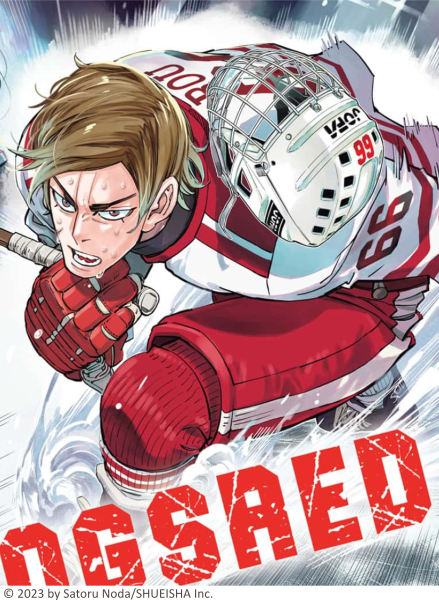
A Rare Opportunity
When I opened the first chapter of DOGSRED, I was greeted by the elegant shape of the figure skater, Shirakawa Rou, instead of the robust bodies of ice hockey players bumping violently into each other. But when I swiped to the second page, a different image of Rou appeared. His body, clad in an ice hockey uniform of dominant reds and crouched in attack mode, filled the entire frame. Already intrigued by the images of the two dissimilar sports, I wondered where the manga would take me. Well, of course, I knew it was about ice hockey, which was the exact reason why I chose it.
There are gazillions of baseball, soccer, or basketball manga to choose from, and there are many I’d love to read and talk about here. However, my aim for this blog is to cover a wide array of sports. So, when I found out that Noda Satoru (the author of Golden Kamuy) would publish a remake of the ice hockey manga Supinamarada!, I was thrilled and jumped at the opportunity.
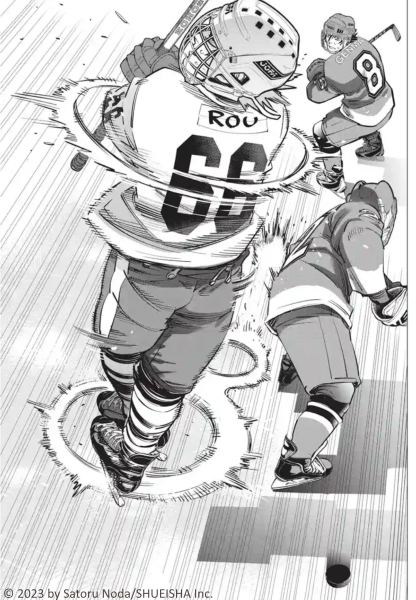
Supinamarada! was Noda-sensei’s debut series in 2011 after working nearly 10 years as an assistant. But the manga failed to entice the readers and was discontinued after six volumes. The mangaka’s subsequent series, Golden Kamuy, was immensely popular, though, with 31 volumes published since 2014, an anime adaptation in four seasons, and a movie release in 2024. After this huge success, Noda-sensei revisited the hockey manga and gave it another try.
A Prince For Ice Hockey
After the introductory images, I found myself in the midst of a group of blushing female fans, all wearing a t-shirt emblazoned with Rou’s face and hoisting banners adorned with hearts to cheer him on. It was late 2010, and the fifteen-year-old elite figure skater was in the middle of performing the final program at the All-Japan Figure Skating Junior Championships in his hometown of Yokohama. Rou’s mother, who trained him since he was little, created the choreography, accompanied by the captivating melody from Swan Lake. Sadly, right before the competition, his mother died in a car accident, right next to Rou, who survived with just a cut on his right cheek. Although DOGSRED begins with such a dismal backstory, it isn’t about coping with the loss of a loved one. In fact, the emotional impact of the mother’s death is touched upon only superficially, making it clear that the story’s focus is on ice hockey.
Despite the tragedy of his mother’s death, Rou poured his heart and soul into the program. The expressive and emotional performance of the “beautiful” prince was hailed as being “amazing” and “simply stunning.” It blew away fans as well as judges and, in the end, secured him first place. His loyal fans already saw the exceptional talent shine brilliantly at the Olympics. But Rou had different plans.
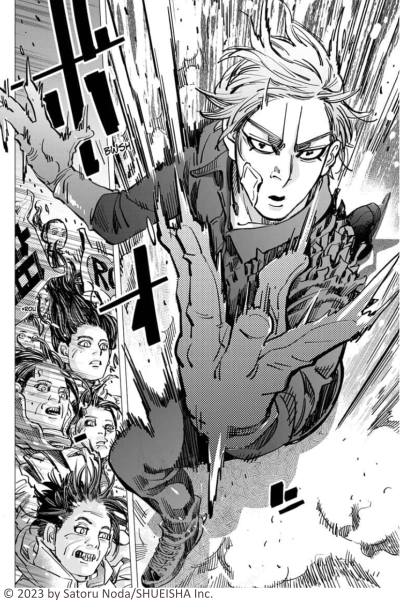
Chapter one isn’t called “the rabid prince” for nothing. After his performance ended and the results were announced, Rou threw chairs onto the ice in a violent tantrum and, executing a roundhouse kick, cut through a sponsor’s billboard with the razor-sharp blades of his skates. Why he did so is explained later in the manga, but I won’t spoil this in this post. For now, the reason for Rou’s behavior was only speculated about in the news. The two female announcers also talked about his past, his future, and his good looks. The final, both chiding and prophetic remark by the announcer reflects the image associated with ice hockey: “If he wants to be a rowdy, he should take up ice hockey!” Admittedly, there are other ways to retire from a sports career, but Rou’s outburst hinted he was indeed destined for a more ‘brutal’ sport.
“What Kind Of Sport Is Ice Hockey?”
From what I’ve read, ice hockey seems to be a quite brutal sport—particularly in the NHL, causing injuries ranging from lacerations and concussions to fractions in various parts of the body. Most are caused by bodychecks or by getting hit with the stick or the puck. With this in mind, I was curious to see how DOGSRED would depict the sport. Will there be injuries and blood? Will there be ruthless fighting? Or will humor and comic relief be used to mitigate the depicted sports violence?
As you can see, I was intrigued even before opening the first chapter. Yet, for those who needed an extra nudge to keep reading, the announcer’s remark might have been just the spark to ignite their interest. And in case it wasn’t, Noda-sensei sought to pique the readers’ curiosity by asking outright: “What kind of sport is ice hockey?” Fortunately, the mangaka didn’t leave us in the dark but kindly provided us with an answer to this question. So, while Rou and his twin sister Haruna were on the way to their grandfather in Hokkaidō, we readers were given a first introduction to this sport. Now then, let’s see how Noda-sensei wants us to perceive ice hockey, shall we?
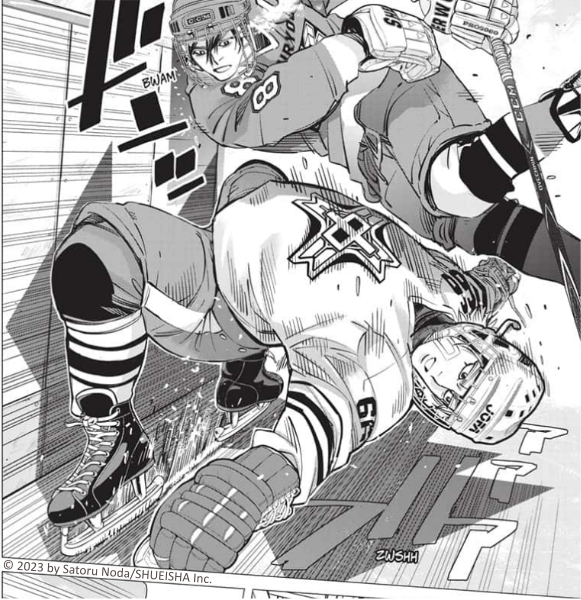
Our first encounter with ice hockey is during the All-Hokkaidō High School Championship between Tomakomai’s top dog, Oino-Kami High, and another school that we’ll most likely never hear about again. Here too, it was the announcer who had been tasked to teach us about this “combat sport on ice.” I could practically hear his ecstatic voice reverberating in my ears as he shared his opinion and showered the sport with praise. The soccer-basketball-rugby mix isn’t just about grappling with your opponents over a small, black puck… No! “It’s a sport combining both strength and beauty,” the announcer seemed to shout. I imagined his voice cracking with excitement when he confessed his love for the sport: “I love ice hockey for its power and technique!” Properly riled up by the exclamatory narration, I was eager to see and learn more about the combat-beauty combination that ice hockey was made out to be. And indeed, my next confrontation with ice hockey was just as beautiful as it was bloody. But first, let’s catch up with Rou, who finally arrived in Hokkaidō.
A Sense Of Tragedy
After Rou and Haruna arrived in Tomakomai in Hokkaidō, they made themselves comfortable at their grandfather’s home. Afterwards, Rou immediately went to a frozen lake to ponder his future.
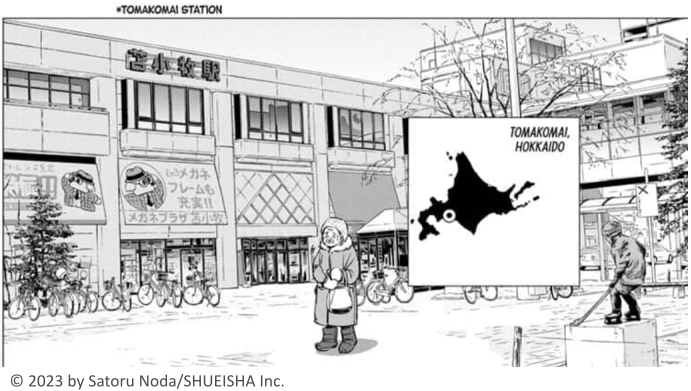
With his career as a competitive figure skater in ruins, Rou had to find new ways to turn his passion into a viable livelihood. While sliding elegantly across the ice, he considered speed skating as an alternative but was dismayed by the prospect of his legs bulking up. “What an awful thought,” Rou contemplated, his face twisting in pain at the idea of having “chunky legs.”
This scene is roughly halfway through chapter one, yet I was already hooked. Despite the seriousness of his (and his sister’s) situation, his touchiness, exaggerated bearing, and stubborn attitude lent themselves perfectly to frequent comic relief scenes that made me smile page after page. Still, as a character, Rou was hard to pin down. While taking notes as the story spun along, various adjectives to describe him kept popping up in my head… only to be immediately discarded. None would fit. Noda-sensei might have foreseen a reviewer’s struggle and offered a helping hand through the little girl, Tomoko, who came to the lake to play hockey with her friends. The group of kids observed Rou, and Tomoko finally said, “His every move emanates a sense of tragedy.” What a perfect description. Watching the former figure skater lamenting the muscle-bound future of his quadriceps in theatrical silence, she added, “I bet he bears an immense weight of suffering.” Little did he know that soon the attack of a ‘barbarian’ out for blood would take his mind off this frightful future.
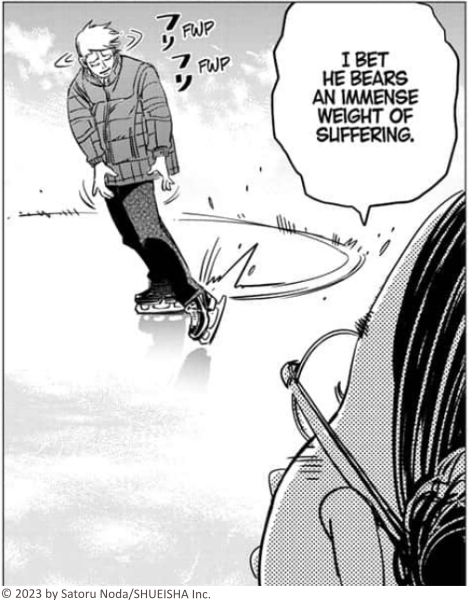
“Sounds Like A Sport For Barbarians”
So far, we’ve received only second-hand information and opinions about what ice hockey and its players are like. Rou provides us with our first in-person experience at the lake, where he is viciously attacked by Genma Keiichi, a ‘bloodthirsty and barbaric’ ice hockey player. But why did he attack the former figure skater?
Well, the kids told Rou they weren’t allowed to use the single goal that stood forlorn on a well-tended and perfectly smooth patch of ice on the lake. Those who dared to enter the forbidden territory had to face the fury of ‘demon’ Keiichi. The kids explained: “He beat up some high school kids for fooling around here… and used their blood to draw the goal line.” Then, as a reminder for us and as first-time information for Rou, the kids excitedly told him that ice hockey is a combat sport where you risk fainting and pooping yourself. Rou was not intimidated, but rather disgusted, and called ice hockey a “sport for barbarians.” He even knowingly provoked an attack by skating deep into the demonic barbarian’s territory. Clearly, Rou wasn’t fainthearted and as dramatically as ever made it clear that he wouldn’t shirk from a fight because, of course, “running in fear is an ugly sight!”
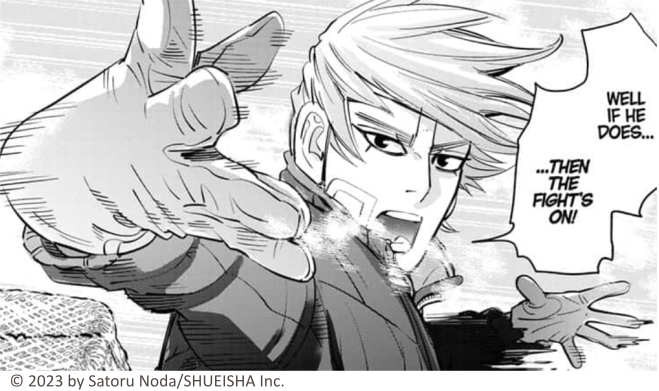
When Keiichi arrived at the lake, he saw the trespasser and promised to paint not only the goal line but the whole rink with Rou’s blood. Thus, the battle for dominion over the goal was on. If you want to know how it went, please read the manga. I can tell you this much, though: it’s a riveting clash between that rabid prince and the infuriated barbarian that won’t allow you to take your eyes off the screen. I was so entrapped by the to-and-fro that I forgot to pause and take notes. Well, after all, it was a serious battle with Rou’s life on the line, as it takes a lot of blood to paint an entire rink. Yet, his perfectly executed movements combined with the carefree chatter left me as much in awe as they made me chuckle. What a unique character; I want to see more of this quirky guy, I thought to myself, swiping on eagerly.
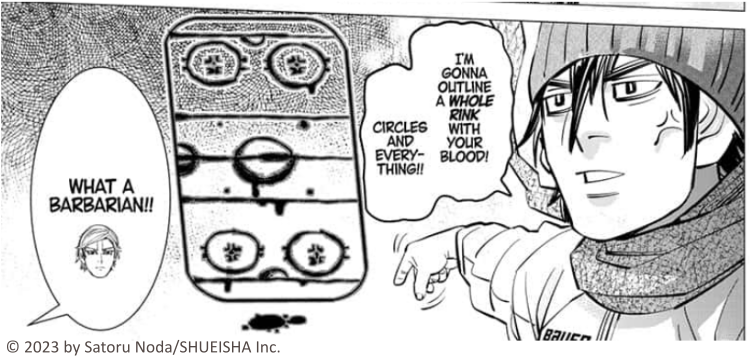
Recalling Noda-sensei’s earlier question, I wondered how this scene added to the answer. Now, the words “barbarian” and “blood” clearly marked both ice hockey and ice hockey players as… well, barbaric and bloodthirsty. Keiichi is hot-headed, aggressive, and prone to ‘drawing blood.’ But Rou is tarred with the same brush. Despite his dramatic demeanor, he is stubborn, loves provoking ‘thugs,’ and isn’t averse to violence—you might remember the chair-throwing incident. In conclusion, Rou possesses character traits that are perfectly suited for being an ice hockey player, just as the announcer in the beginning suggested—provided that the image Noda-sensei painted is true. However, the former figure skater disliked ice hockey for its lack of grace. Soon, though, he would change his mind because the sport would undergo a fairytale transformation before Rou’s eyes. However, before we could witness this, it was time for the ‘education arc.’
Learning From Mistakes
Hockey class took place during an actual game at the regional junior high prelims in which Rou participated as part of a tradeoff he agreed on with the team. He had exactly two hours to prepare for the match. Two hours to get equipment, learn the rules, and apply tactics. His grandfather, who was an ice hockey player and even played at the 1972 Sapporo Winter Olympics, lent him his decades-old protective equipment and stick. As for the rest, Rou had to acquire it through hands-on learning. Just as I, he knew nothing about this sport and spent quite some time in the ‘sin bin’ or penalty box, as it’s officially called, serving time for the many fouls he committed. But thanks to his ignorance, we readers also learn a lot about ice hockey, particularly what is and isn’t allowed. For example, you can stop an airborne puck with your hand, but you are not allowed to pick it up and skate around with it. The stick must stay below shoulder level and must not be used as a weapon. We also learned that line changes (exchange of players) are based on the accumulation of lactic acid, thus muscle fatigue. And, last but not least, coach Nihei told us that “ice hockey is all about skating.”
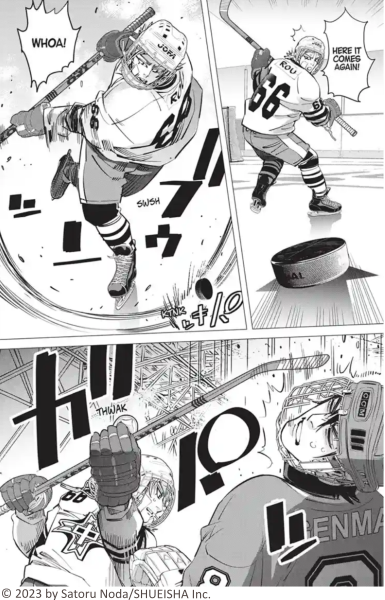
Rou’s most distinguished traits were his tenacity and fearlessness. He fought wholeheartedly, fearing neither his opponents nor making mistakes. Regardless of the constant scolding, the frequent trips to the penalty box, and the audience’s jeers, his determination to move the puck toward the goal never wavered. His lack of knowledge about hockey was compensated for by his outstanding skills on the ice. A demonstration of his versatility prompted a history lesson about a real-life athlete with similar impressive abilities, ‘Sid the kid’ Sidney Crosby. Rou’s perfect command of his body on the slippery surface impressed opponents and teammates alike and also caught the eye of Oino-Kami’s head coach, Nihei Toshimitsu. Hence, the figure skater’s biggest contribution was his unyielding fighting spirit, which motivated not only his team but also brought the crowd to his side. In the end, he enjoyed the time he spent with his teammates to such a degree that it sparked an earnest curiosity about this rough sport. This curiosity prompted him to watch the final of the National High School Ice Hockey Championship… where he fell for ice hockey for good.
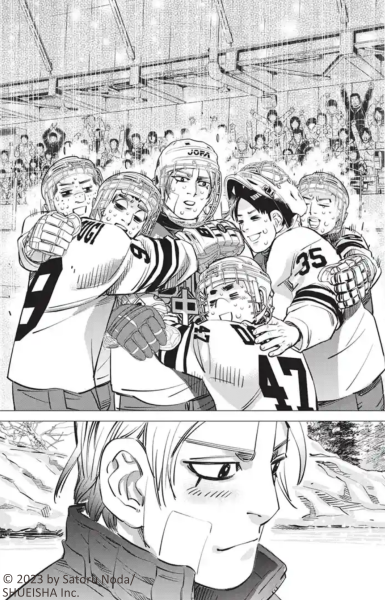
But I too was captivated by Noda-sensei’s depiction of the prelims and couldn’t wait for the final. Drawn by the meticulously crafted images, I inched my reading device closer to my nose, determined not to miss a single detail. Page after page, I followed the players as they sped across the ice in pursuit of the puck, and I could practically hear the scraping of the blades and the thundering noise when they crashed into each other to gain the upper hand. At the same time, the unexpected comic relief scenes put many broad smiles upon my face.
Apart from learning about ice hockey, you’ll also find a rich tapestry of references to people, places, and festivals, as well as history and geography lessons in DOGSRED. If you are interested in following the trails of information crumbs Noda-sensei left in the manga, I’d advise you to keep your search engine up and running. You’ll need it regularly.
The Ugly Duckling
The final of the National High School Ice Hockey Championship took place in Tomakomai between Oino-Kami High from Tomakomai and Sameoh High from Hachinohe in Tōhoku. The stakes were high for Oino-Kami because a victory would mark their 20th consecutive win. Rou came to watch but couldn’t find a spot to sit in the jam-packed arena, so he had to be content with standing all the way in the back. Naturally, this was not a befitting spot for the former ice skater, so he soon settled himself comfortably next to Oino-Kami’s coach and his players on the bench.
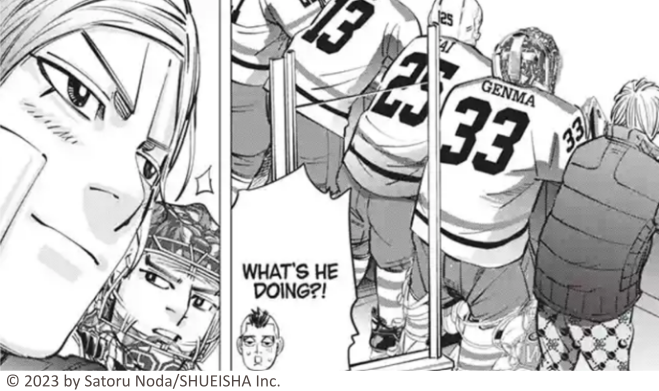
At first, I thought my eyes played a trick on me when I found him amidst the benched Oino-Kami players. But then again, the pattern of his tracksuit was unmistakably unique, so there was no doubt about it. (His socks have the same pattern, by the way.) On the bench, he cheered for Oino-Kami’s team, shared the thrills and setbacks, gave them high-fives and congratulatory pats on their backs, and also commented on the proceedings of the game. With Rou on the frontlines, we readers got a front-row view of the game, too. And I must say, it was awesome! Contrary to the, at times, rough and minimalist drawing of the faces (some of which I had to get used to), the visualization of the game, the equipment, including the individual plays, were in such detail that it almost felt as if I were watching a real game. Noda-sensei guides the readers through the whirlwind action on the ice so that you can immediately grasp what’s going on. This is not a given! A while ago, I read Shojo Fight, and the matches in this manga were hard to follow. I had to swipe back and forth to retrace the ball’s movement across the court. This didn’t happen in DOGSRED. There, I could easily follow the franticly moving puck thanks to the guiding arrows and held it comfortably in my field of vision, no matter how fast-paced the game was. Only my bated breath and tight grip on my reading device were indications of the tension and excitement that radiated from every page during the matches.
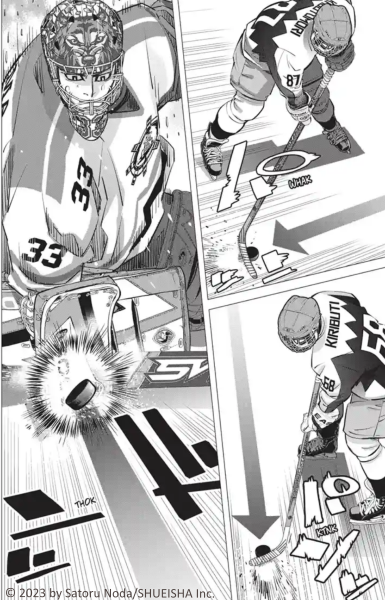
Rou must have felt the same excitement while watching the final. Much like the baby swan in The Ugly Duckling, ice hockey and its players transformed from unsightly and graceless to elegant, strong, and beautiful. Leaving the bench and the arena after the final whistle, Rou commented on the game: “This was incredible! The players were strong but elegant! Real ice hockey is a beautiful sport! I’m glad I came to watch!” After this, Rou was no longer content with being a spectator and, therefore, enrolled at Oino-Kami High to become an ice hockey player.
Reality Check
Noda-sensei set the beginning of the story in 2010. The Interhigh match between Oino-Kami and Sameoh from Hachinohe in Tōhoku took place in January 2011. After the successful final, the students of Sameoh were back in their classrooms. Then, on March 11, 2011, the earth beneath their feet shook violently, foreshadowing a catastrophe of unimaginable proportions.
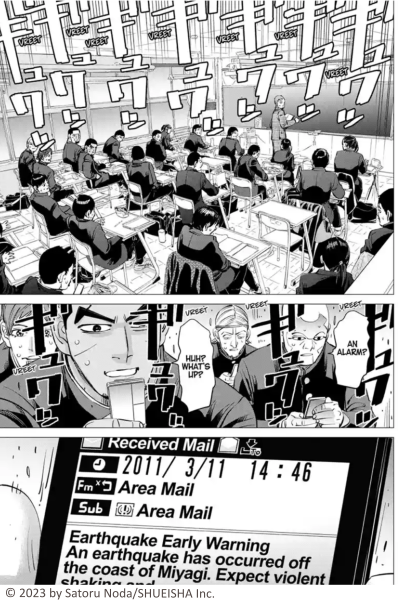
The sudden shift from a fun and enjoyable sports comedy to a real-life disaster caught me off guard, especially since during the first twelve chapters my risorius muscle wasn’t given a single moment to relax. The disastrous incident told from the perspective of the students at Sameoh provided a harsh dose of reality. Entertainment was on a halt. Interspersed with the accounts of eyewitnesses, this chapter gave glimpses into what happened in the aftermath of the Great East Japan Earthquake. Of course, the story told in the manga is superficial and only covers the first two weeks. But, I assume, most people will be well-informed anyway, so bits and pieces of information should suffice as a reminder.
I wondered how Noda-sensei would turn the ship around after evoking such horrid memories. To this end, he presented us with a tiny ‘miracle.’ The kids of Sameoh High ice hockey club were housed in an evacuation center, just like many other people. The boys lost their belongings, including their ice hockey gear. One of them, Gonohe, wondered, “Does the world even need ice hockey? Better join the Self-Defense Forces or be a fireman.” To this, his teammate, Kiribuchi, replied, “It’s important to reclaim our lives from before the quake. Even if it’s just ice hockey.”
One might feel like criticizing Noda-sensei for ‘using’ the earthquake to attach such a high value to sports. On the other hand, the story shows that in times of great distress, holding on to a small piece of normalcy, even if it might not be heroic, is just as important for getting back on one’s feet. And so the boys rejoiced when they found the protective gear washed up nearby, telling them to continue to play ice hockey. And thus, the training arc commenced.
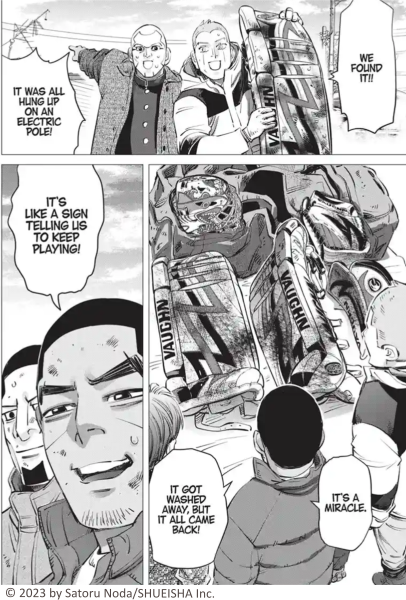
Lord Of The Water
April 2011 marks the start of the training arc, where some of the previously introduced characters joined Oino-Kami’s ice hockey team in the new school year. Among them were the ‘barbarian’ Genma Keiichi, two of Rou’s teammates, Dohi and Kosugi, and, of course, Rou himself. To become proper team members, they had to pass a hellish dry-land training session under coach and ‘Lord of the Water’ Nihei Toshimitsu.
While participating himself, Dohi filmed the training in the Experimental Forest with his first-generation-GoPro and published the result as a documentary on his social media channel. So, the huffing and puffing of the dehydrated boys and their strenuous efforts for a few drops of water were accompanied by Dohi’s expert commentary on the ‘legendary’ stages of the training, like the “legendary hydration line” or the “legendary exposed belly-button relay.”
I contemplated if I should include the ‘science vs. guts’ topic in this post, since I already touched upon it in my last post about Oblivion Battery. But considering that the power struggle between Rou and Nihei for the vital resource water is given such a dominant part in this section, I couldn’t ignore it. And here’s how it goes. The young athletes had to complete a run around Oino-Kami Lake in fifty seconds; otherwise they were not allowed to drink water. “No drinking without permission,” the coach said. “Are you serious?!” Rou replied shocked, “In this day and age?!” Surprisingly, none of the other boys protested, and when Rou tried to get his hands on the precious liquid, they even wrestled the bottle from his grasp. Yet, Rou kept protesting: “Refusing to allow people to drink is archaic!” he said.
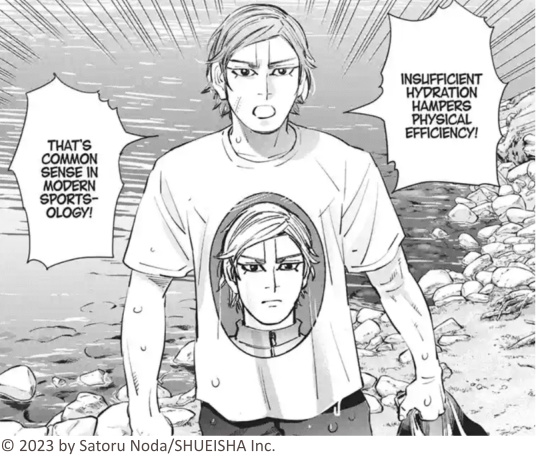
I wanted to dig up some additional information on the importance of hydration during physical activities, but the comedic elements in these scenes brilliantly glossed over the gravity of the issue. Chuckling at the humorous depiction of the situation, all I could do was swipe to the right… and was immediately presented with the coach’s counterargument. This included—among other things—the prophecy that in the near future sports science will be proven wrong. The rest was somewhat degrading, so I don’t want to cite it here.
I disagreed with coach Nihei, but both the young athletes and, later, Rou seemed to approve of this training method through their behavior and comments. Dohi even states in his documentary that “This grueling training is the foundation of Oino-Kami’s 19-year reign as champs!” Well, what else can I say…? If the students didn’t mind, why should I? Long forgotten is Rou’s argument that child athletes have actually died of heatstroke because of this and similar training methods.
Bad and idiotic coaches can be found anywhere in the world, and I’ve encountered some myself. I know that there is a time and place for drinking water during training, and that filling your stomach to the brim is counterproductive. Still, withholding it or handing out water as a reward is beyond stupid.
Even though in reality the coach’s training method would warrant harsh criticism, the depictions in DOGSRED are ‘just’ part of the fictional manga world. Additionally, the portrayal is so over-the-top that it made me smile in spite of myself.
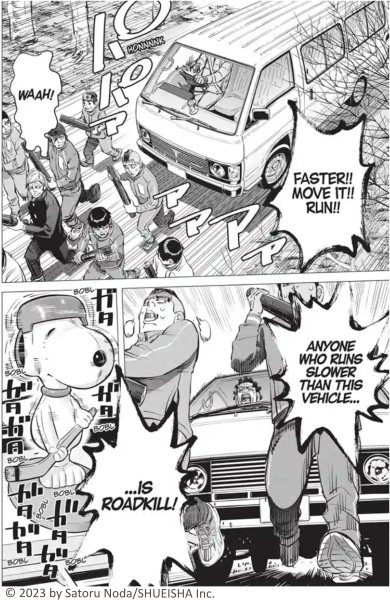
Humor And Hockey
I’ve only read the first two volumes that cover chapters 1 till 16, but there are already three volumes out in Japanese and 31 chapters available on the MangaPlus app (at the time of writing). I love the humor, I love the art, and based on what I’ve read so far, the story is going to be a sports comedy that I will gladly swipe through to lift my spirits and recharge my battery. Furthermore, Rou is a protagonist that just pulls you along, and you can’t help but find him endearing. Now that I’ve published this post, I’ll reward myself with the next chapter of the charming Rou and his endeavor to learn ice hockey.
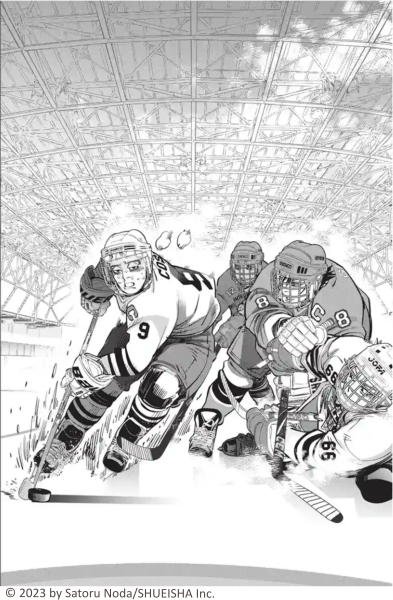
Note to 1*) “But in thy look, what bitter smart!” is a line in Johann Wolfgang von Goethe’s poem Welcome and Farewell. The poem tells the tale of the euphoric feeling of meeting a loved one and the bitter emotions as the two lovers must part.
Note to 2*) Blood pictures refer to works by Austrian painter Hermann Nitsch, where he used blood instead of paint.
Links:
- DOGSRED
- on MangaPlus (in English)
- on Young Jump (in Japanese)
- Japan Ice Hockey Federation: https://www.jihf.or.jp
- About injuries in ice hockey
- Interview with Noda Satoru
- in asahi.com (in Japanese)
- in Business Insider (in Japanese)
- an English translation in kamuycentral
Subscribe to never miss a deep dive into the exciting world of sports anime, manga, and manhwa!

